On our way back home to North Carolina from our vacation in Michigan, Chrissy, Opal and I stopped by a collecting site in Huron County, Ohio. Our buddy, Jay Loch, told me about the location on the West Branch of the Huron River just north of Monroeville where Ohio's version of septarian nodules could be found along with pyrite nodules.
After a terrific cookout the night before with my family in Charlevoix, Michigan, we were on the road at 6:00 AM Saturday, July 10, 2004. We were closely watching the sky as we drove south on I-75 as the weather report called for a good chance of severe thunderstorms in southern Michigan and northern Ohio, right where we were heading. The last thing that we needed was a big rain as it would wash out our collecting plan for the day.
After grabbing a quick lunch in a nearby town, we made out way down to the collecting area on the river. Contrary to the weather report, there was no sign of any impending rain storm, although it was quite humid. We parked our truck and camper next to a cornfield and walked a few hundred yards down to the river. We decided to start at a point south of the bridge and slowly make our way northward.
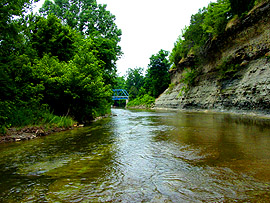
Bridge over the West Branch of the Huron River
(looking north)
The calf to knee-high water flows northward over horizontal beds of limestone and shale. The water was not particularly cold but was refreshing as we waded up back and forth across the river looking for nodules. Opal quickly discovered that this was her kind of place as she had a blast running full speed back and forth between Chrissy and me.

Opal at full gallop
I observed some huge concretions in the wall above the river. The two largest concretions were like giant footballs elongated parallel to the bedding plane. The biggest one was a whopping 6 feet across - it would take a mighty sledge to break apart that bad boy. I read in the literature that the flattened gray to grayish-black concretions formed around the remains of organic matter as a nucleus, including fossil sharks and petrified wood.
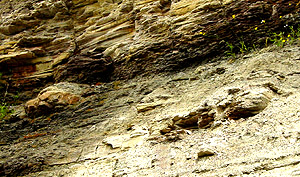
Giant concretions
At some point in the distant past, the mud composing the matrix of the concretions dried out causing them to crack and mineralized groundwater infiltrated the surrounding rock and concretions causing different minerals to crystallize within the open spaces. Concretions with radiating cracks filled with minerals are called septaria or, more commonly, septarian nodules. The minerals found in the Ohio River septaria include dolomite, calcite, quartz, pyrite, barite, and aragonite. The following picture is an example of what are perhaps the most well-known septarian nodules found in southwest Utah.
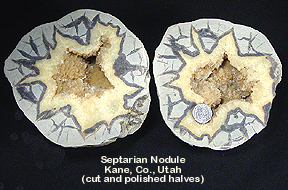
It should be noted that the use of the term "nodule" for what are actually concretions is a misnomer since a concretion is formed from mineral precipitation around some kind of nucleus while a nodule is a replacement body. But, the name septarian nodule, although a misnomer in part, has somehow stuck in the rockhounding lexicon even though they are actually septarian concretions. And to add further confusion to the mix, a hollow mineral laden concretion is called a geode, so it would be more precise to refer to the septarian nodule shown above as a septarian geode. However, since only baboons, monkeys and lice-infested people are happy to see a nit-picker, I'll not buck tradition and continue to misapply the term nodule . . . but you know what I really mean.
I banged on a few rocks south of the bridge but didn't find any decent Septarian nodules while Chrissy and Opal hunted the shoreline.
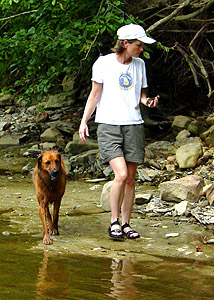
Chrissy and Opal
On the river banks, Chrissy discovered a bunch of small nodules composed of what appeared to be pyrite. The outside of the nodules were completely oxidized to a dark gray/brown color, but it was their relative heaviness that told us that they were probably pyrite. I broke one apart and, sure enough, its interior was metallic. When we got home, I stuck the nodules in oxalic acid for a couple days and they cleaned up nicely as you an see in the following picture - although it is my guess, based on the silvery color, that the nodules are actually composed of marcasite and it is likely that they will re-tarnish and decay over time since the mineral is generally not stable in normal atmospheric conditions.
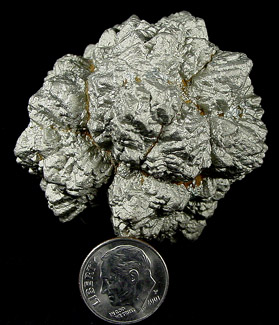
Pyrite (marcasite?) nodule
(click on above picture to enlarge)
We worked our way north under and past the bridge.
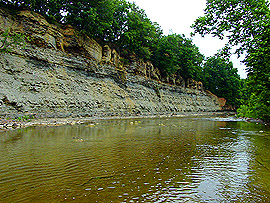
Horizontal bedding north of the bridge
(looking northeast)
We discovered that there seemed to be plenty more rocks to bang on, as compared to the area to the South. It didn't take long before I found a septarian nodule that would be worthy of carrying back to the truck at the end of the day. It is composed of veins of white and brown colored calcite that open up into small pockets.
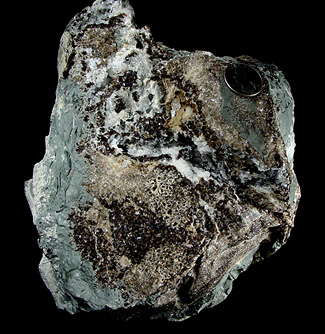
Septarian nodule
(click on above picture to enlarge)
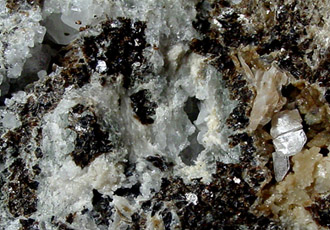
Septarian nodule close-up
(click on above picture to enlarge)
Opal did her best to give me some hints along the way - I've heard of bird dogs but concretion dogs? And, never to be outdone, Chrissy got real good at hatching her own concretions in the river bed.
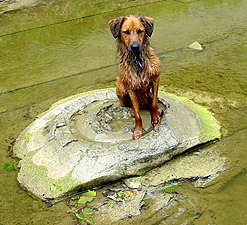
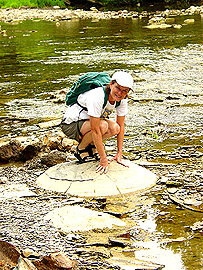
What concretion . . woof?
Leapfrog, anyone?
After several hours of collecting and splashing up and down the river, we made our way back to the truck. We still wanted to put in at least a few hours on the road before bedding down for the night. We were too tired from collecting to search out a campground and set up our camper, so we found a motel off I-75 just south of Lima to spend our last night out.
The only time that we allow Opal to sleep with us in bed is in a motel room, so she was happy . . . maybe too happy . . .

What a loon!